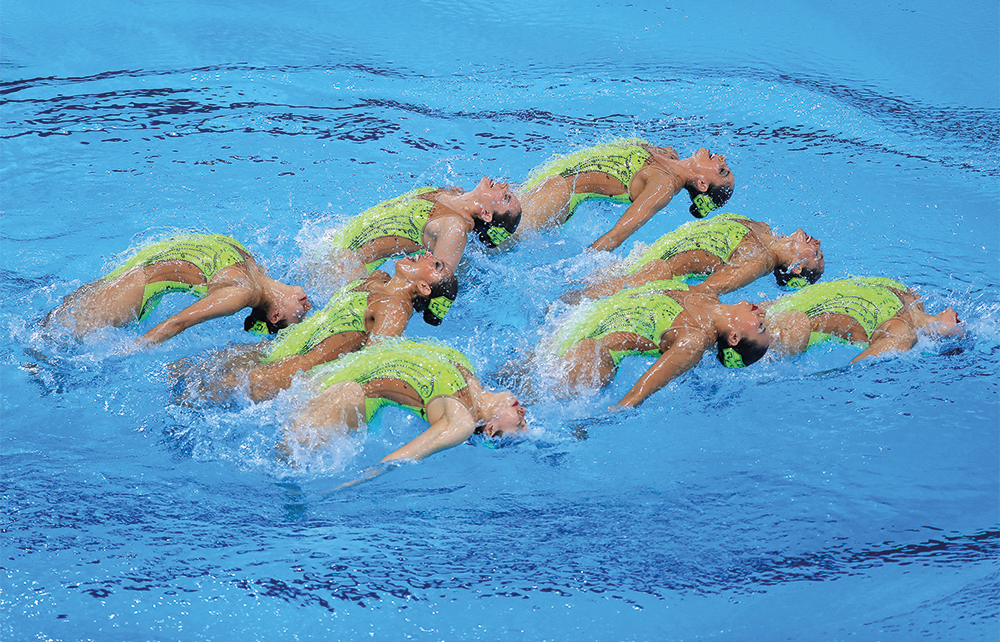Synchronised swimming isn’t really a sport, is it? It’s ‘artistic swimming’ now, of course, though many athletes don’t like that term precisely because it makes the Olympic event sound less like a real sport. But by the end of Swimming Pretty, Vicki Valosik’s meticulous history of synchronised swimming, it’s difficult to think of it as anything other than one of the toughest sports we’ve been watching in Paris – and wonder why anyone would disagree.
That question is one that Valosik addresses in her book, along with making the case for the sheer discipline and power of a synchronised swimmer. Her skill is in doing both without ever sounding plaintive or chippy. Besides, the story she tells is so remarkable that it doesn’t need any forced drama.
Swimming pretty is also dangerous, and has been ever since women started performing in tanks of water – some of which shattered, sending them flying among shards of glass. Divers have come up blind, their retinas shredded by the impact of the water. Esther Williams, the swimming filmstar whose photo was one of the most requested by American GIs, broke three vertebrae in her neck and nearly snapped her spinal cord in a dive when the metal crown she wore forced her head back and sent ‘lightning bolts of pain through her body’. Competitive swimmers have passed out underwater. Journalists in the 1980s mocked synchronised swimming, then gave it a go, and emerged from the water gasping in shock. ‘This is the hardest sport in the world,’ admitted Dave Barry of the Miami Herald.
It has been a difficult journey over the years for these pretty swimmers. Not only have they battled the danger of holding their breath underwater and endured the weight of the garments they were forced to wear to preserve their modesty, they have had to fight a society that largely assumed that women just didn’t swim.
Divers have come up blind,
their retinas shredded by
the impact of water
They were allowed into the water for mineral bathing, which was considered acceptable as long as they wore large gowns and entered from a bathing machine that was pulled to the water’s edge by a horse. Even then, men would gather at a distance to watch them through telescopes in what they called ‘naiad hunting’. Of course, these peeping toms weren’t the ones who were criticised. Valosik quotes one 19th-century London newspaper blaming women for failing to ‘confine their water frolics to the bath under the awning, but boldly wander away and so expose themselves to the vulgar throng’.
The male gaze is a constant theme of the book. In the 1920s, when women first became lifeguards, they found themselves rescuing men who revived remarkably quickly – as in the case of the American swimmer Ruth MacNeely, who was the first female guard on the Jersey Shore. One day the scene repeated itself so often that
it became apparent to the manager that the men just wanted to be rescued by the young woman. If any man was in trouble after that he was on his own, because the beach manager ordered MacNeely to assist only women and children.
In the second world war, swimmers performed for wounded soldiers, and Virginia Hunt Newman was surprised to see many of them leaving the stands as she was diving. ‘She later found out they had gone to the pool’s subterranean level to watch through the underwater windows, hoping to catch a glimpse as Newman adjusted her top after each dive.’ She concluded both that the men weren’t ‘as sick or wounded as they would have you believe’ and that ‘it made you feel really part of the war effort’.
Swimming was extremely important in the war: soldiers needed to be proficient in case they ended up in the sea; and training to move quickly through water that might be filled with debris, or swim with just one arm, clutching a rifle in the other, involved learning synchronised swimming. Indeed, it was men who moved swimming on from being something people did either as a performance or to save lives to being a competitive sport. Top athletes now train for up to 14 hours a day; but there is still a fine line between artistry and athleticism, with complaints about nose clips obscuring the ‘beauty’ of competitors. Valosik, a synchronised swimmer herself, horrified her teammates when she insisted on wearing goggles at her first meet. ‘You can’t make eye contact with the judges while wearing goggles,’ one pointed out to her. ‘It just isn’t done.’
What she does do in this book is to give an exhaustive history of swimming pretty without exhausting you. Her writing is lively and takes you right into each moment, then sends you off to tell everyone else about how tough this beautiful sport is – even if trying it sounds like a very tall order.








Comments